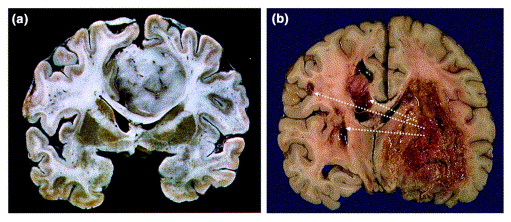Malignant glioma is an aggressive and life-threatening form of brain tumor that arises from glial cells, which support and nourish neurons. These tumors are classified as high-grade gliomas, including glioblastoma multiforme (GBM), anaplastic astrocytomas, and oligodendrogliomas. Malignant gliomas exhibit rapid growth, high invasiveness, and poor prognosis.

Causes and Risk Factors
Although the exact cause of malignant glioma remains unclear, several risk factors have been identified:
- Genetic mutations: Alterations in tumor suppressor genes (TP53, IDH1, PTEN) and oncogenes (EGFR, PDGFRA) contribute to tumor development.
- Radiation exposure: Individuals exposed to ionizing radiation have an increased risk of glioma formation.
- Age and gender: Gliomas are more common in older adults, with a higher prevalence in males.
- Family history: A small percentage of cases have a hereditary component.
- Environmental factors: Exposure to carcinogenic substances such as pesticides and industrial chemicals may contribute.
Symptoms of Malignant Glioma
The symptoms of malignant glioma depend on the tumor’s location and size but often include:
- Persistent headaches
- Seizures
- Cognitive impairment and memory loss
- Personality and behavioral changes
- Vision and speech disturbances
- Nausea and vomiting
- Weakness or numbness in limbs
Diagnosis and Imaging Techniques
Early and accurate diagnosis is crucial for treatment planning. The following diagnostic tools are used:
- Magnetic Resonance Imaging (MRI): Provides detailed brain scans to detect tumor size and location.
- Computed Tomography (CT) Scan: Used for initial screening in emergency settings.
- Biopsy: A sample of the tumor tissue is examined histologically to determine malignancy.
- Molecular Testing: Identifies genetic mutations that influence treatment decisions.
Treatment Options
Malignant glioma requires a multidisciplinary approach, combining surgery, radiation, and chemotherapy:
1. Surgical Resection
Surgery is the first-line treatment aimed at maximal tumor removal while preserving neurological function. Complete resection is challenging due to gliomas’ infiltrative nature.
2. Radiation Therapy
Post-surgical radiotherapy targets residual tumor cells to slow progression. Techniques include:
- External beam radiation therapy (EBRT)
- Stereotactic radiosurgery (SRS)
3. Chemotherapy
Temozolomide (TMZ) is the standard chemotherapy drug used in combination with radiation therapy to improve survival rates.
4. Targeted and Immunotherapy
- Bevacizumab (Avastin): An anti-angiogenic drug that inhibits tumor blood vessel growth.
- CAR-T Therapy & Checkpoint Inhibitors: Experimental treatments enhancing immune response against glioma cells.
Prognosis and Survival Rates
Despite aggressive treatment, malignant gliomas have a poor prognosis:
- Glioblastoma Multiforme (GBM): Median survival is 12–18 months.
- Anaplastic Astrocytoma: Median survival is 2–5 years.
- Ongoing clinical trials aim to develop novel therapies to improve outcomes.
Malignant glioma is a highly aggressive brain tumor requiring a comprehensive treatment strategy. While current treatments extend survival, research into new therapies continues to offer hope for improved patient outcomes.

